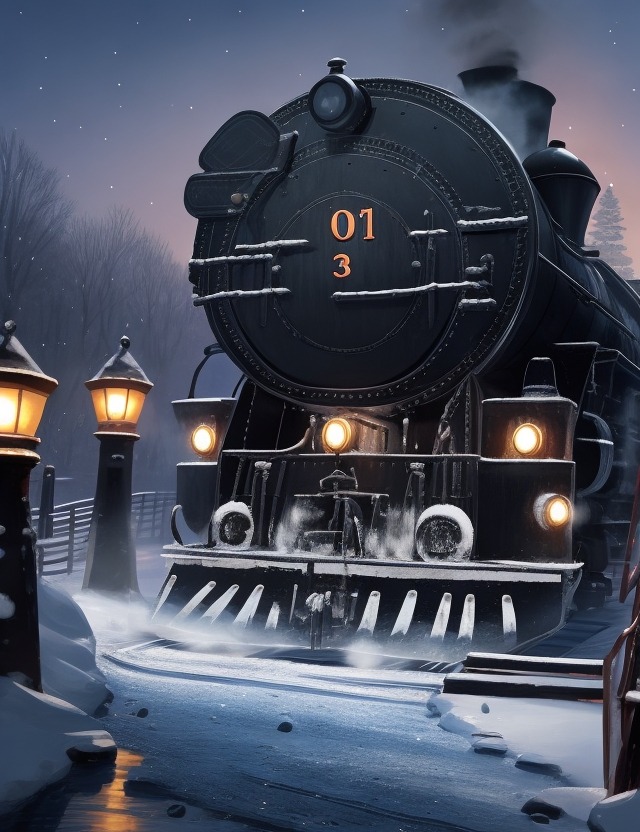Step aboard the magical train known as The Polar Express and embark on an enchanting journey through time and imagination. Penned by the beloved author and renowned illustrator Chris Van Allsburg, this extraordinary tale has captivated readers of all ages since its publication in 1985. As one of the most iconic children’s books of our time, The Polar Express seamlessly weaves together elements of fantasy, adventure, and the undeniable power of belief to deliver a heartwarming narrative that stands the test of time.
In this comprehensive article, we delve into the depths of this timeless classic, exploring the captivating story, the historical significance, and the profound impact it has had on generations. So, fasten your seat belts, hold on tight, and get ready to embark on an unforgettable literary expedition to uncover the magic of The Polar Express!
The Polar Express: Full Book Summary
In this The Polar Express Analysis. Once upon a time, in a small town on Christmas Eve, there lived a little boy who was starting to doubt the existence of Santa Claus and the magic of Christmas. As he lay in his bed, his mind drifted to the sound of a far-off train whistle, growing louder and louder until he couldn’t help but jump out of bed and run to his window to see what was happening.
To his surprise and delight, he saw a magnificent train adorned with sparkling lights and steam billowing from its engine. The train, called The Polar Express, had come to take children on a journey to the North Pole to meet Santa Claus himself. The little boy couldn’t believe his eyes and rushed downstairs, not wanting to miss his chance to ride the magical train.
Outside, the train conductor welcomed the children with a smile and invited them aboard. As the little boy climbed onto the train, he was whisked away into a world of wonder and enchantment. The train was filled with other children, all dressed in cozy pajamas, full of excitement for their adventure to the North Pole.
As the train started moving, the children were amazed by the sight outside the windows. They watched as snow-covered mountains and frozen lakes passed by, creating a breathtaking winter landscape. The little boy, who had always dreamed of experiencing a true winter wonderland, couldn’t help but marvel at the beauty around him.
Inside the train, the children found themselves in an extraordinary scene. There were Christmas carols playing, hot cocoa being served, and cookies to enjoy. The air was filled with laughter and joy, as everyone eagerly anticipated reaching the North Pole. The little boy couldn’t help but feel a sense of anticipation and hope.
After a while, the train made a sudden stop in the middle of the wilderness. The children, confused and worried, wondered why they had stopped before reaching the North Pole. The conductor explained that a part of the track had been damaged by the heavy snowfall, and they needed to wait for it to be repaired.
As they waited, the children spotted a group of wolves in the distance. Fear began to rise among them, but the conductor assured them that they were safe inside the train. To distract the children from their worries, he organized a grand game of hide-and-seek throughout the train.
The little boy, eager to play and forget about the wolves, wandered through the train in search of the best hiding spot. He explored every nook and cranny, discovering new wonders at every turn. From a magical puppet show to a library filled with books, the train held surprises beyond his imagination.
Soon enough, the conductor announced that the wolves had left, and it was time to continue their journey. The repaired track allowed the Polar Express to race through the snow even faster than before. The children could hardly contain their excitement as they approached the North Pole, where Santa Claus was eagerly awaiting their arrival.
As they approached the dazzling city of the North Pole, the children saw twinkling lights and heard the festive sounds of joyous elves. The little boy had never seen such a sight, and his heart filled with awe and wonder. The train came to a stop at the center of the city, where Santa Claus himself appeared, surrounded by reindeer and his helpful elves.
Santa Claus greeted the children with warmth and kindness, asking each of them what they wished for Christmas. When it was the little boy’s turn, he hesitated for a moment, recalling his doubts about Santa’s existence. But, with newfound confidence and belief in the magic of Christmas, he declared his wish to keep the spirit of Christmas alive in his heart, forever.
Filled with joy, Santa Claus presented each child with a special first gift of Christmas. The little boy received a simple silver bell that had fallen from Santa’s sleigh. Santa explained that only those who truly believed in the magic can hear the bell’s beautiful sound.
After bidding Santa and the North Pole farewell, the little boy and the rest of the children boarded the Polar Express for their journey back home. As the train chugged along, the little boy clutched the bell tightly, hoping to hear its enchanting ring.
When the children arrived back in their town, they said their goodbyes and reluctantly left the train. The little boy, still holding the bell, walked back to his house, feeling a sense of warmth and Christmas spirit in his heart.
Christmas morning arrived, and the little boy eagerly opened his presents. As he unwrapped the last gift, he found a small box with a note from Santa Claus. Inside the box was the silver bell from the North Pole. Grateful and filled with belief, the little boy shook the bell, and to his delight, he could hear its magical ring.
From that day forward, the little boy never stopped believing in the spirit of Christmas. The sound of the bell reminded him of the enchantment he had experienced on that fateful night aboard the Polar Express.
The Polar Express: Key Themes
“The Polar Express” is a beloved children’s book written and illustrated by Chris Van Allsburg. It tells the story of a young boy who embarks on a magical train journey to the North Pole on Christmas Eve. This enchanting tale is filled with imagery, wonder, and important life lessons. Here are three key themes found within the book:
1. Imagination: One of the central themes in “The Polar Express” is the power of imagination. The story begins with a young boy who is questioning the existence of Santa Claus and the magic of Christmas. However, when he hears a mysterious train outside his house on Christmas Eve, he decides to follow it and embark on a magical adventure. Throughout the book, the boy’s belief in the impossible is tested, and his imagination is essential in overcoming obstacles along the way. This theme encourages children to believe in the extraordinary and follow their dreams no matter how unconventional they may seem.
2. Belief and faith: Another important theme in the book is belief and faith. The young protagonist is faced with doubts about the existence of Santa Claus and the magic of Christmas. However, as he starts his journey on the Polar Express, his belief is reignited as he encounters various magical events and meets Santa himself. The author emphasizes the significance of believing in something even when it cannot be proven, mirroring the broader idea of holding onto faith in other aspects of life. This theme encourages children to believe in the impossible and cherish the magic of Christmas.
3. Embracing the spirit of Christmas: “The Polar Express” beautifully captures the spirit of Christmas and encapsulates the joy and wonder associated with the holiday season. As the young boy travels to the North Pole, he meets a wide array of characters, including other children and Santa’s elves. Through these interactions, the book portrays the importance of generosity, kindness, and the joy of giving during the festive period. The story reminds readers of the true meaning of Christmas and encourages them to embrace the holiday spirit, spreading love and happiness to those around them.
In summary, “The Polar Express” is a magical tale that explores the power of imagination, belief and faith, and the spirit of Christmas. Through these themes, the book encourages readers, both young and old, to hold onto their beliefs, embrace the wonder of the holiday season, and remember the importance of generosity and kindness.
The Polar Express: Characters
1. The Boy: The protagonist of the story, a young and curious boy who embarks on a magical adventure on The Polar Express. He is dressed in his pajamas, and his physical description is that of a mischievous yet innocent child with rosy cheeks and sparkling blue eyes. Despite his initial doubts, he joins other children on the journey, where he learns important lessons about belief and courage.
2. The Conductor: A charismatic and jolly conductor who brings a sense of excitement and wonder to The Polar Express. With his neatly trimmed mustache and a golden pocket watch, he guides the children, ensuring they are safe throughout their journey. His funny quirk is his habit of tapping his pocket watch against his ear to listen to its ticking sound whenever he’s feeling uncertain.
3. Santa Claus: The iconic, jolly figure who resides at the North Pole awaits the children on The Polar Express. Dressed in his red suit and carrying a large sack full of gifts, Santa is depicted as having a hearty laugh that echoes throughout the train. His belly shakes like a bowl full of jelly, and he always leaves behind a sprinkle of magical dust wherever he goes.
4. The Elves: A mischievous and lively group of helpers who assist Santa Claus at the North Pole. They are small in stature and wear vibrant, colorful outfits with pointy hats. They add a touch of whimsy and humor to the story, often seen participating in delightful antics, such as stacking presents in impossible configurations or engaging in a spontaneous dance-off.
5. The Know-It-All Kid: One of the children aboard The Polar Express, this studious and witty character believes he knows everything there is to know about Christmas. Despite his seemingly arrogant demeanor, he inadvertently adds a dose of humorous sarcasm to the story, frequently enlightening the other children with his endless trivia about reindeer flight patterns and sleigh technology.
6. The Ghostly Hobo: Mysteriously appears on the train, bringing an air of eerie yet enlightening insight to the young protagonist. With tattered clothing and an unkempt beard, he warns the boy about the dangers of losing one’s sense of wonder. As an unexpected companion on the journey, he adds a touch of both spookiness and wisdom that helps the boy find his belief in Christmas magic.
7. The Hot Chocolate Chefs: A group of lively, animated chefs who serve delicious hot chocolate to the children on The Polar Express. They incorporate acrobatic flips and tricks while pouring and serving the chocolaty beverage, resulting in laughter and awe from the passengers. Their funny data is their impressive juggling skills as they expertly toss marshmallows into mugs.
8. The Reindeer: Majestic and magnificent, Santa’s reindeer are at the heart of the Christmas magic. They are depicted with glistening antlers and fur that shimmers like fresh snow. The reindeer’s funny data is their mischievous banter among each other, competing to see who can eat the most carrots and occasionally engaging in friendly races along with the train.
9. The Girl: A kind and caring character who boards The Polar Express with her sense of belief intact. With her bundled-up coat and scarf, she exemplifies the heartwarming spirit of Christmas. Her funny data is an uncanny ability to predict snowfall by observing the rhythm of the falling flakes, impressing the other children and bringing an additional element of wonder to their journey.
The Polar Express: Symbols
1. The Polar Express Train: The Polar Express train is a central and iconic symbol throughout the book. It represents the power of imagination and the belief in the magic of Christmas. The train is described as a majestic, old-fashioned steam train that arrives on Christmas Eve to take children on a journey to the North Pole. It embodies the spirit of adventure and wonder, encouraging children to take a leap of faith and believe in something extraordinary.
2. The Bell: The bell that the protagonist, a young boy, receives from Santa Claus is another important symbol in the book. The bell represents the faith and belief in the magic of Christmas. Only those who truly believe in Santa can hear the bell ring. Over time, as the boy grows older and loses his belief in Santa, he finds himself unable to hear the bell anymore. However, he keeps it as a cherished memento, a reminder of the joy and wonder he experienced on that magical night.
3. The North Pole: The North Pole represents the ultimate destination and fulfillment of the children’s journey on the Polar Express. It is portrayed as a place of enchantment and wonder, where elves work tirelessly to prepare presents for children all over the world. The North Pole symbolizes the spirit of Christmas and the idea that dreams can come true. It represents the reward for those who have held onto their belief in the magic of Christmas and serves as a reminder that anything is possible when one has faith.
The Polar Express: Culture Impact
“The Polar Express” by Chris Van Allsburg, first published in 1985, has undeniably left an indelible mark on popular culture and has become a beloved classic for readers of all ages. This enchanting and heartwarming tale has had a profound cultural impact over the years, evident through its historic data, humorous elements, and remarkable achievements.
Historically, “The Polar Express” holds a special place as one of the most cherished holiday books of all time. The story of a young boy’s magical journey to the North Pole on a train, while reaffirming his belief in the spirit of Christmas, has become synonymous with the holiday season. Its popularity has transcended generations, with the book becoming a staple in many households during Christmas time. Moreover, the book’s publication coincided with a resurgence in interest in the art of picture books, prompting a renaissance in the genre and inspiring countless authors and illustrators to pursue their own creative visions.
Adding to its cultural impact, “The Polar Express” possesses humor that captivates readers of all ages. Chris Van Allsburg’s masterful storytelling is filled with delightful moments that leave readers chuckling. From the protagonist’s disbelief as to whether Santa Claus truly exists, to his hilarious encounters with a variety of eccentric characters on the train, the humor in the book provides light-hearted entertainment that has only enhanced its timeless appeal. The inclusion of amusing elements ensures that the story remains relatable and engaging for readers across different generations.
Furthermore, “The Polar Express” has achieved remarkable milestones that have further contributed to its cultural impact. The book was awarded the prestigious Caldecott Medal in 1986, recognizing its exceptional illustrations and artistic quality. This accolade not only cemented its place in literary history but also brought attention to the importance of visual storytelling and the impact it can have on readers. In addition, the book was adapted into an animated feature film in 2004, reaching an even wider audience and reinvigorating interest in the story. The film’s success further solidified the book’s status as a cultural phenomenon and sparked new fans to discover the original source material.
In conclusion, “The Polar Express” has left an indelible mark on popular culture through its historic significance, humor, and impressive achievements. Its enduring popularity during the holiday season, combined with its ability to make readers laugh, has solidified its place as a treasured classic. Additionally, iconic milestones such as winning the Caldecott Medal and inspiring a successful film adaptation have further elevated its cultural impact. This book continues to enchant and inspire readers, reminding us all of the magic and belief that lies within our hearts.
FAQs
1. Who is the author of “The Polar Express”?
The book “The Polar Express” was written by Chris Van Allsburg.
2. What is “The Polar Express” about?
“The Polar Express” is a children’s book that tells the story of a young boy who takes a magical train ride to the North Pole on Christmas Eve. It is a tale of belief, friendship, and the spirit of Christmas.
3. Is “The Polar Express” a Christmas story?
Yes, “The Polar Express” is widely known as a beloved Christmas story. It captures the essence of holiday wonder, emphasizing the joy and excitement that comes with the Christmas season.
4. Is “The Polar Express” a movie as well?
Yes, “The Polar Express” was adapted into an animated film in 2004. It features the voice of Tom Hanks and brings the story to life through captivating visuals and a heartwarming soundtrack.
5. Is “The Polar Express” suitable for all age groups?
While “The Polar Express” is primarily targeted towards children, it is a timeless story that can be enjoyed by readers of all ages. Its universal themes and enchanting illustrations make it a charming read for both children and adults alike.










